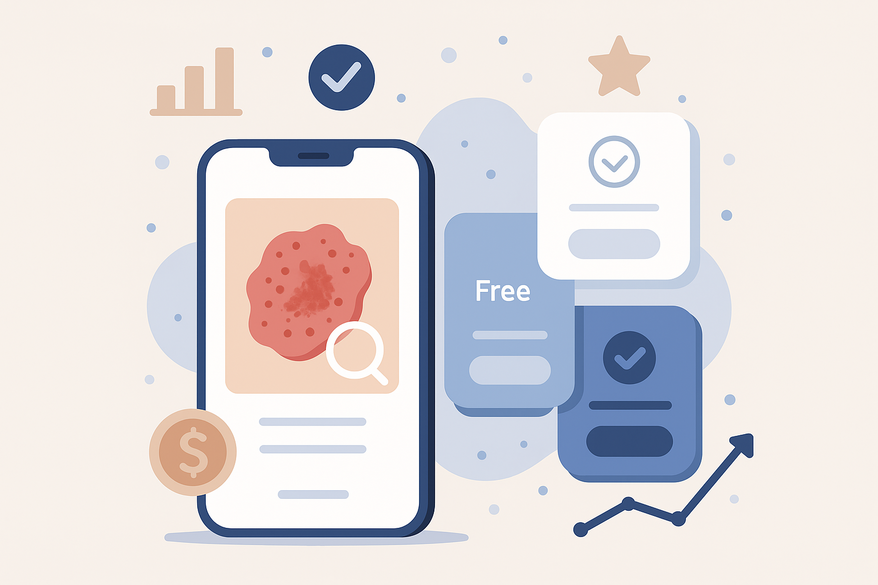Understanding Rash App Pricing Plans: A Comprehensive Guide
Discover comprehensive insights into rash app pricing plans, including free trials, subscriptions, and the best value for effective skin monitoring.

Estimated reading time: 8 min read
Key Takeaways
- Diverse Pricing Models: Freemium, free trials, monthly, annual, and one-time purchases cater to various user needs.
- Value Maximization: Annual plans often offer significant savings over monthly subscriptions.
- Feature-Based Tiers: Higher-priced tiers unlock advanced AI diagnostics, expert chat, and priority support.
- Cost-Benefit Considerations: Assess hidden costs, auto-renewals, and compliance before subscribing.
- Choosing the Right Plan: Match usage frequency, desired features, and budget to select the optimal plan.
Table of Contents
- Section 1: Overview of Rash App Pricing
- Section 2: Detailed Look at Subscription Models
- Section 3: Factors Influencing Pricing Plans
- Section 4: Cost-Effectiveness and Value Analysis
- Section 5: Considerations When Choosing a Plan
- Conclusion
Section 1: Overview of Rash App Pricing
Keywords: rash app pricing plans
In the competitive world of healthcare technology, rash detector apps employ a variety of pricing structures to suit different user needs. By offering multiple tiers—from a free trial to lifetime access—developers can attract both casual users and professionals. This flexibility also ensures sustained revenue for ongoing research and updates.
Common Pricing Models:
- Free Trial: Typically 7–14 days to explore core features, boosting user confidence before purchase.
- Monthly Subscription: Recurring fee ($4–$12/month) for continual access; auto-renews unless canceled.
- Annual Plan: One-time payment for a year (20–30% discount), offering cost predictability and savings.
- One-Time Purchase: Lifetime access via a single fee, though rare in AI health apps due to ongoing update needs.
- Freemium: Basic rash scans are free; advanced diagnostics and expert consultations require payment.
Section 2: Detailed Look at Subscription Models
Keywords: rash app pricing plans
2.1 Subscription Option Types
- One-Time Purchase
- Pros: No recurring fees; simple ownership.
- Cons: No continuous updates or model retraining.
- Recurring Fees
- Monthly Subscription: Lower upfront cost; flexibility to cancel.
- Annual Plan: Discounted rate; locks in users for 12 months.
2.2 Features Mapped to Pricing Models
Here’s a typical breakdown of features by plan:
- Free/Freemium
- Basic rash scan
- Limited symptom tracking
- Introductory AI feedback
- Monthly/Annual Subscription
- Advanced AI diagnostics
- Unlimited scans
- AI or expert chat
- Priority support
- Regular model updates
- One-Time Purchase
- Basic to mid-level access
- Limited updates
- No priority support
2.3 Real-World Examples
- Rash ID: Free core diagnosis; premium features via subscription, including AI chat and scan history.
- Aysa: Freemium on Google Play with condition screening; premium offers personalized advice.
- Google Derm Assist: Free diagnostics; paid add-ons for detailed reports.
For a detailed comparison of feature sets and pricing across leading tools, see the comprehensive guide.
Section 3: Factors Influencing Pricing Plans
Keywords: rash app pricing plans
3.1 Technology Sophistication
High-accuracy AI models and extensive dermatology databases increase R&D and computation costs, often leading to premium pricing.
3.2 Feature Set
Expert chat, symptom tracking, reminders, and detailed history enhance value and justify higher tiers.
3.3 Market Demand & Use Case
- Urgent care vs. routine monitoring: urgent use cases command higher fees.
- Geographical factors: regions with limited clinic access may pay more for remote diagnostics.
Value Proposition: Upfront subscriptions can reduce clinic visits and long-term medical expenses by catching issues early.

Section 4: Cost-Effectiveness and Value Analysis
Keywords: rash app pricing plans
4.1 Evaluating Worth
- Monthly vs. Annual Math: $9.99/month = $119.88/year vs. $79.99/year → 33% savings.
- Incremental Feature Assessment: Unlimited scans, AI chat, expert consultation, and detailed reports.
Explore affordable solutions at affordable AI skin diagnosis solutions.
4.2 Long-Term Benefits
- Early detection saves on urgent care costs.
- Continuous updates maintain diagnostic accuracy.
4.3 Hidden Costs
- Auto-renewals if you forget to cancel.
- In-app purchases for expert consultations.
- Upgrade fees when switching tiers mid-cycle.
Section 5: Considerations When Choosing a Plan
Keywords: rash app pricing plans
5.1 Key Questions to Ask
- What are free trial limits?
- How and when does auto-renewal occur?
- Is the app HIPAA-compliant?
- Are expert consultations included or extra?
5.2 Practical Tips
- Choose annual if you monitor frequently.
- Opt for freemium for occasional checks.
- Read reviews to gauge support quality.
“Rash ID’s free features let me check my rash instantly, and the premium version’s AI chat was detailed and helpful. Worth the subscription for peace of mind.”
Conclusion
From free trials and freemium tiers to monthly and annual subscriptions, rash app pricing plans cater to diverse needs. Assess your monitoring frequency, required features, and budget to find the best value. Start with free versions, compare premium offerings, and select the plan that offers peace of mind and cost savings.
Call-to-Action: Try multiple free trials, list must-have features, and choose the plan that balances cost, utility, and peace of mind.
FAQ
1. Are reliable free rash detector apps available?
Yes. Many apps offer free core diagnosis features. Premium services like detailed analysis and expert advice typically require a subscription.
2. What happens after a free trial ends?
Access to premium features is blocked until you subscribe. Always note the trial’s end date and terms to avoid surprises.
3. Can I cancel anytime, and how do refunds work?
Most subscriptions allow cancellation at any time. Refund policies vary by platform (App Store, Google Play), so check the details before subscribing.





